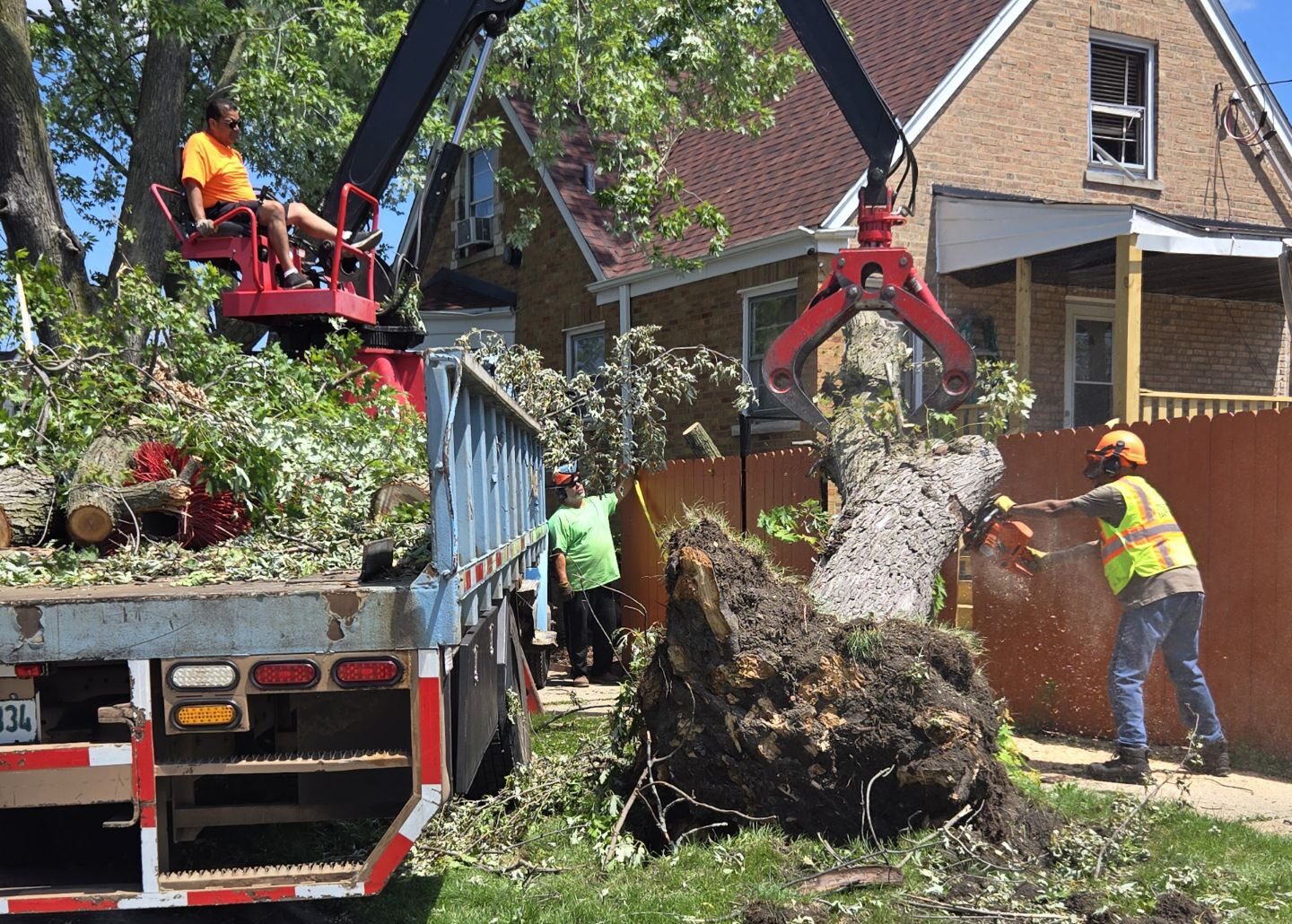What we’re watching: Weekly disaster update, July 22

Editor’s note: The “What we’re watching” blog posts are currently on a summer schedule. A new post will be published on a biweekly basis. The next blog will be published on Aug. 5.
We know all too well that disaster can strike anytime, anywhere in the world. Some disasters make headlines; others do not. Here at the Center for Disaster Philanthropy (CDP), we monitor the status of disasters worldwide and compile a list of the ones we’re tracking weekly, along with relevant disaster-related media coverage.
Here’s what we’re watching for the week of July 22, 2024.
New or Emerging Disasters
Derechos – Midwest: There were two derechos in the Midwest just days apart. The July 13 system struck Montana and the Dakotas.
At least 35 tornadoes have been confirmed by the National Weather Service (NWS) as a derecho went through northern Illinois and northwest Indiana on July 14 and 15. At least one person died and nearly half a million customers were without power at the height of the outage. NWS said the majority were EF-0 and EF-1 storms.
In a rare occurrence, there were low-level twisters on consecutive days inside Chicago city limits.
Flooding – Afghanistan: On July 15-16, eastern and northeastern Afghanistan was hit by flash floods, rain and wind. At least 29 districts across six provinces were affected. There are ongoing power outages and initial reports indicated “extensive damage and destruction of private properties, civilian infrastructure and agricultural land.”
In Nangarhar Province, there were 50 fatalities, 350 injuries and 351 families in need of shelter. In total, there have been 58 fatalities and 380 people injured. Nearly 2,000 families across three provinces have been assessed. Hundreds of homes have been damaged or destroyed. Save the Children says about 1,500 children have lost their homes.
At the Torkham border crossing (where almost 420,000 returning Afghan refugees have crossed since November 2023), 550 tents were destroyed, along with damage to Water, Sanitation and Hygiene (WASH) facilities. Previous severe floods in May 2024 saw the destruction of about 1,000 homes and the deaths of 300 people. Many people have been sleeping outdoors since that event.
International Rescue Committee director Salma ben Aissa said in a statement, “The continuation of climate-induced disasters in Afghanistan ought to be cause for grave concern: decades of conflict and economic crisis has meant that the country has faced setback after setback as it tries to find its feet. The sad reality is that without a massive increase in support from donors and the international community, many more will lose their lives.”
For more information about the ongoing crisis, see our Afghanistan Humanitarian Crisis.
Flooding – U.S.:
- Illinois: A dam in Illinois was at risk of failing after about 6 inches of rain fell and homes filled with several feet of water.
- Missouri: Approximately 200 homes in Nashville, near St. Louis, Missouri were evacuated after heavy rain on July 16 led to the failure of two dams.
- Arkansas: A 500-year flood occurred in Arkansas as 6 to 11 inches of rain fell in a short time.
Flooding – China: Heavy rains leading to flooding caused destruction in China’s northwest and southwest. In the northwest, a highway bridge in Shaanxi province partially collapsed on July 19, leaving 20 dead and dozens missing.
Ten people were killed and 29 missing in Sichuan province in the southwest after 40 homes were destroyed. In addition, local media reported that “roads, bridges and communication networks in hardest hit Hanyuan county had been damaged or knocked out.” Some areas of the country received a year’s worth of rain in just a few hours.
Flooding – South Korea: In mid-July, heavy rain caused floods in South Korea’s border city of Paju and the surrounding metropolitan area in Gyeonggi Province. Paju received a record-breaking 15.2 inches on July 17, the highest one-day July rainfall since tracking began in 2001. On July 20, communities in southern Korea received as much 3.5 inches of rain per hour over three hours leading to flooding. Seoul experienced 25 inches of rain between July 18 and 19, with more expected on July 20.
Korean newspaper, Korea JoongAng Daily, reported that a special government meeting led to several relief measures including decisions to “designate additional special disaster areas, supplementing the already designated five, to provide financial aid and expedite restoration efforts. Plans also include stabilizing crop supplies by quickly assessing farmers’ eligibility for disaster insurance and providing 50 percent of estimated coverage in advance.” The rainfall has greatly affected the watermelon harvest.
Korea’s monsoon season should be over soon as it began on June 19 and usually lasts for about a month. However, Typhoon Gaemi, which formed east of the Philippines on July 20, may push more rainfall over the country.
Flooding – West and Central Africa (multiple countries): Multiple countries in West and Central Africa have experienced flooding this year. The Democratic Republic of Congo is the worst hit, with 182,000 of the 271,000 people affected so far. Across five countries, 26,000 homes have been destroyed or damaged, 154 people are missing and 33 people have died. There is a significant loss of farmland, which will impact food security.
Previous/Ongoing Disasters
H5N1 – U.S.: Extreme heat is believed to have been a contributing factor in what is now the U.S.’s biggest bird flu outbreak in people. For the first time ever, a cluster of cases has been detected in the U.S., after six poultry workers tested positive for H5N1 in Colorado.
Poultry workers were culling chickens known to be infected with the virus but sweat and cooling made it challenging to keep Personal Protective Equipment sealed properly.
The Guardian reported on July 19 that, “Of the 160 people working on the farm, 60 went on to develop symptoms, and five tested positive or are presumed to be positive.” A sixth worker has since tested positive. Bird flu has a 50% mortality rate among humans. This brings the total number of cases in the U.S. to 10 since April, 11 all time.
CNN reported, “The virus has affected 18.32 million birds from 34 commercial flocks and 16 backyard flocks since April. The US Department of Agriculture is also reporting a growing number of infected cattle, with confirmed cases in 157 dairy cow herds across 13 states.”
Hurricane Beryl – Multiple Countries:
U.S.: After weeks without power, many Houstonians are breathing a sigh of cold air as the number of customers without power dropped below 6,000 on July 21. But at least 23 Houstonians died because of heat since Beryl, with many others affected.
Canada: Remnants of Hurricane Beryl caused record-setting rain in the city of Toronto, leading to a billion-dollar disaster on July 17. Streets and homes were flooded as four inches fell very quickly.
Grenada/Saint Vincent and the Grenadines: UN OCHA reported: “The initial Regional Overview and Planned Response document calls for US$9 million to respond to the most urgent humanitarian needs of 43,000 people in the worst affected areas in Saint Vincent and the Grenadines and Grenada. The UN Central Emergency Response Fund (CERF) immediately allocated $1.5 million to kickstart operations. Over the next six months, five UN agencies and their implementing partners will use CERF funds to address the needs of 12,000 to 15,000 people in logistics, food security, shelter, WASH and early recovery, including agriculture, coastal management and fisheries.”
In both countries, agricultural losses will likely cause food shortages and increased costs, as well as the need to import more food. Other islands, such as Trinidad and Tobago, that depend on exports will also have food insecurity issues.
In Jamaica, assessments indicate that the agriculture sector losses from Beryl are at least $27.6 million USD ($4.73 billion JMD). Nearly 50,000 farmers and 11,200 fishers were impacted, 57,000 acres of croplands were damaged, and nearly 325,000 animals were killed.
For more about this year’s tropical events, see our 2024 Atlantic Hurricane Season disaster profile.
Humanitarian Crisis – Haiti: A recent visit to Haiti by three representatives of the United Nations and the European Commission, emphasized the extent of the ongoing crisis in the country.
At the end of the tour they said, “The multidimensional humanitarian emergency facing Haiti requires urgent attention and strategies that go beyond emergency measures … What Haitians want most is peace, which will allow them to return to school, to cultivate their fields, to access basic services such as going to the hospital … Millions of families are calling for an end to this ongoing violence. It is critical to scale up protection services for women and children, who are bearing the brunt of this crisis, and increase humanitarian assistance for those in need.”
For more information about this crisis, see our Haiti Humanitarian Crisis disaster profile.
Flooding – New Mexico: Since the devastating June wildfires that destroyed nearly 1,600 homes in Ruidoso, at least 200 more homes have been lost during eight different flooding events. The latest round of flash flooding occurred on July 20 due to the monsoon rains.
There is an increased risk of flooding in a burn scar for about five years after a fire due to the lack of vegetation. Because the South Fork and Salt fires occurred on a mountain, rain streams down into the town, carrying along with it debris flows of water, vegetation and mud.
Flooding – India: The state of Assam continues to experience flooding that began in June. Heavy rainfall has been causing rising river levels leading to riverine flooding, as well as flash flooding caused by the rain itself.
As of July 17, 823 villages underwater. A total of 113 people have died, with 3.3 million affected. At least 24,501 houses have been damaged, including 3,306 that are destroyed.
Heat – Global: Several countries across Europe are continuing to deal with extreme heat, now exacerbated by wildfires.
France 24 said, “Unrelenting heat is blanketing swathes of southern and eastern Europe, with dozens of cities on red alert as scorching temperatures fuel wildfires, strain power grids, and make daily life unbearable.”
Wildfires have occurred in Greece and Italy. There are even swarms of locusts in the eastern region of Emilia Romagna, Italy.
In addition to the disasters listed above, we actively monitor the following disasters or humanitarian emergencies. For more information, see the relevant disaster profiles, which are updated regularly.
- 2024 East Africa Flooding and Cyclones
- 2024 North American Wildfires Profile
- 2024 U.S. Tornadoes Profile
- Gaza-Israeli Humanitarian Crisis
- Horn of Africa Hunger Crisis
- 2024 Rio Grande do Sul Brazil Floods
- Sudan Humanitarian Crisis
Complex Humanitarian Emergencies – Chad
Many places worldwide are experiencing emergencies caused by conflict, climate change, drought, famine, economic challenges and other conditions that combine to create a complex humanitarian emergency (CHE). CDP maintains complete profiles on several CHEs, and what CDP considers Level 1 CHEs are profiled in this weekly blog post and tracked.
According to the country’s Constitutional Council, Chad’s junta leader General Mahamat Idriss Déby won the May 6 presidential election with 61% of the vote. The election occurred after three years of military-backed rule and the runup led to high tensions and violence.
Against this political climate, the country experiences chronic underdevelopment and poverty, widespread acute food insecurity, a health crisis, and an influx of refugees and returning migrants from neighboring Sudan.
Since the beginning of the conflict in Sudan on April 15, 2023, there has been an influx of people forced to flee, including Sudanese refugees and Chadian returnees who arrived spontaneously in Chad. The majority of registered people crossing the border into Chad are women and 89% are women and children.
Refugees and returnees settle primarily in formal or informal camps. In camps, access to health services is limited to due physical access and resource constraints. Malaria, acute respiratory infections, malnutrition and watery diarrhea are the most common pathologies according to the World Health Organization.
Between June 2024 and January 2025, the Famine Early Warning Systems Network (FEWS NET) projects the eastern provinces, along the border of Sudan, will experience worsening food security outcomes. FEWS NET says, “The steady influx of refugees and returning migrants is straining livelihoods and intensifying competition for the few available economic opportunities.”
Upcoming webinar
Aug. 8: Feminist humanitarian funding approaches in climate and disaster crises

What We’re Reading
- Why these 10 humanitarian crises still demand your attention – The New Humanitarian: Conflicts such as Gaza and Ukraine have dominated headlines, but these 10 other conflicts also need attention.
- (VIDEO) How bootcamps are helping to address the historic gap in internet access on US tribal lands – Associated Press: A significant digital divide exists in Indian Country where large land masses often mean cell signal is unavailable. Read how bootcamps are helping reduce the digital divide and improve access to emergency services, telehealth and more.
- Home Insurance Rates in America Are Wildly Distorted. Here’s Why. – New York Times: “New data makes it possible for the first time to see what households pay for home insurance by county and ZIP code, across the United States.” Check out our webinar to learn more about insurance and how losing insurance options affects disaster philanthropy.
- Lessons From Lahaina: Upcountry Maui Residents Prepare To Flee As Crater Road Fire Burns – Honolulu Civil Beat: CDP grantee partner, Honolulu Civil Beat, covers how officials are using lessons learned from the fire in Lahaina last year as a new fire burns on Haleakala.
- World is not on track to reduce vulnerabilities and risks – SDG Pulse: “Persisting increase in greenhouse gas emissions threatens development progress and future generations’ opportunities to live in a sustainable world…We must change course. Continuing the trajectory of climate change, biodiversity loss, pollution and ecosystems degradation will unravel progress on the SDGs, exacerbating hunger, poverty, conflict, disasters, and health crises.”
- UN declares 2025 to 2034 the decade to combat increasing sand and dust storms from Africa to China – Associated Press: “On July 10, the U.N. General Assembly on Wednesday declared 2025 to 2034 the United Nations Decade on Combating Sand and Dust Storms — extreme weather events that are increasing and threatening health and economies from central Africa to northern China.”

Something fun: Our director of domestic funds, Sally Ray, watched Twisters this weekend, but not just because she is interested in everything disaster. Her husband Bill Ray’s family homestead is featured in the film. Built by Bill’s great-great-grandfather, a German immigrant in the late 1880s, Sally’s mother-in-law was raised there, and the farm is still in family hands. Sally notes that, although Bill’s great-great-grandfather bought the land from the government, it was still Native land at the time of purchase.
